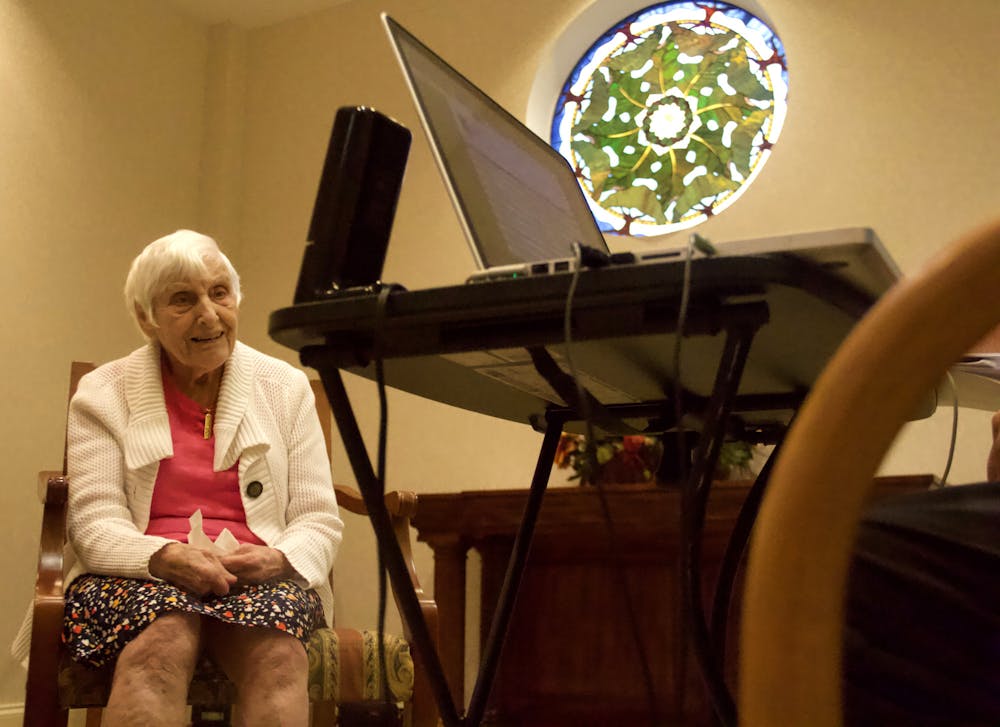The sapphire and green stained-glass window wraps 92-year-old Peggy Weigle in sunlight and warmth. Weigle is not in church, but her mind is still finding salvation in melodies.
In a small room in her retirement community, she snuggles her orange-and-blue Gators blanket. Her drowsy head dips, heavy eyelids framed by wiry glasses.
Meanwhile, Dean Martin croons the lyrics, “Memories are made of this,” over two laptop speakers. Music becomes a key as it starts to wedge into Weigle’s past.
Martin’s rich baritone transports her back to the 1950s. Her feet come alive, padded socks tapping against her wheelchair footrests with a precise rhythm. The corners of her eyes crinkle, and her lips curl upward.
The movements are slight. If you blink, you might miss them, but they’re there just as her memories are — you just have to search hard enough.
To honor National Alzheimer’s Awareness Month, Oak Hammock Retirement Community at UF hosted a Music & Memory event Nov. 5. The organization uses music to help residents recall specific memories linked to songs that span across every era and genre.
The digital library includes every top 10 song from 1930 to 1970. Research suggests that cognitive function can improve when listening to familiar music.
Once an elementary school music teacher, Weigle’s rhythm and zest for life persist decades later.
Her daughter Diane sat beside her, remembering when Weigle played piano and sang her to sleep. Weigle loves music from all around the world. At her first teaching job, she taught special education students English from across the border of Juárez, Mexico.
For many memories, Weigle’s forehead furrows as she struggles to recall the major details of her life. But then, Frank Sinatra’s “Strangers in the Night” lulls over the speakers.
Love was just a glance away, a warm embracing dance away ...
Weigle knows she once danced to this song. Back then, there was no wheelchair, and she felt safe in the arms of a man who knew he would marry her from the moment the two first locked eyes.
Lovers at first sight, in love forever.
This was their song — her late husband she shared 55 years with. Her eyes widened.
“George,” Weigle said.
Working intently on a laptop, resident Phillip Morrison is the DJ of memories. The volunteer of five years sometimes dresses the part, donning a black cowboy hat and a bandana around his neck for those who love country music.
“It’s like a scavenger hunt to try to find out what music gets a positive response,” Morrison said. “To see the smiles or the enjoyment that comes, it’s just so fulfilling.”
Morrison said he knows how much the little moments of respite and joy matter. His mother had Alzheimer’s disease and several of his family members lived in nursing homes.
“I saw the joy that music could bring to people who don’t have that much control,” he said. “That’s something I want to do.”
As he travels back to residents’ youth with the playlist, he encounters a wide spectrum of responses. But for one married couple, the music is particularly effective.
Although her husband is in the memory care unit, when Morrison hit play on R&B song “Jim Dandy,” the husband playfully wagged his finger. He broke out in dance and twirled his wife around, singing to her.
“That’s how they first met,” Morrison said. “She saw him dancing, and she says, ‘I want to dance with that man.’ So that led to 57 years of marriage together.”
Another resident had been completely unresponsive. She required pulmonary therapy, which Morrison said was uncomfortable. She had no family with her. She resisted the treatment, and so Morrison set out to find the right musical prescription.
After compiling her personalized playlist, the resident powered through her therapy when her aide played the music before and during the session, Morrison said.
“Music has benefits to our wellbeing,” Morrison said. “It should be viewed as a medicine or tool.”
Music & Memory is helping seniors across the world.
The overarching goal of Music & Memory is to promote the proactive use of therapeutic music until it becomes a standard in health care, said Justin Russo, program director.
The right music, especially from someone’s formative years, can retrieve memories by activating their cognition for a brief period of time, Russo said.
“Music is irrevocably part of both our conscious brains and our unconscious brains,” he said.
This concept becomes important when brain function starts to decline during the aging process, particularly for people living with dementia. Music embeds itself in more areas of the brain during formative years, or at about 13 to 25 years of age, Russo said.
Those areas are the last to be touched by even late-stage dementia, he said.
Studies show personalized music reduces anxiety and agitation. Some people with dementia struggle to chew and swallow. Listening to their favorite songs can help people with nutrition issues follow cues to chew and swallow, Russo said.
Repeated exposure to familiar music has been shown to benefit cognitive performance in Alzheimer’s disease patients as well. Recent research investigated the brain mechanisms behind this improvement, according to the Journal of Alzheimer’s Disease.
If someone is played music from their formative years, it generates the most reaction in terms of neuroplasticity — the brain’s ability to respond to external stimuli, such as music, Russo said.
After MRI scans, researchers found participants responded more and displayed signs of neural connectivity. Musicians responded even better, Russo said.
“It puts them in a better position to have their cognition activated, to converse, to socialize, and ultimately, to be present,” Russo said. “It underscores the importance of music-based interventions like Music & Memory.”
The largest ever study conducted on the effects of Music & Memory measured reductions in the amount of antipsychotic medication taken by nursing home residents and declines in distress, Russo said.
Music & Memory was associated with reductions in psychotropic medication use, including antianxiety, antidepressant and antipsychotic medication. Aggressive behaviors, depressive symptoms, pain and falls declined significantly over time, according to a study in the Journal for Post-Acute and Long-Term Care Medicine.
“When you see that face light up when you get the right music, it makes all that effort worthwhile,” Russo said. “We’re really just scratching the surface of what’s possible with music.”
Over the speakers at Oak Hammock, Martin emphasizes the memories you keep: of love, grief and joy, and of wedding bells, homes and kids.
“Stir carefully through the days, see how the flavor stays,” Martin sings. “These are the dreams you will savor.”
Music & Memory offers a free guide on how to create a personalized music playlist for loved ones at home.
Contact Alexandra Harris at aharris@alligator.org. Follow her on Twitter @harris_alex_m.

Alexandra is a senior journalism major reporting on Science/Environment for The Alligator. Her work has appeared in The Gainesville Sun, and she filed public records requests for the Why Don't We Know investigative podcast. She has a passion for the environment.






